|
|
+91 8469279141 hemrajhomeoclinic@yahoo.com
|
|
|
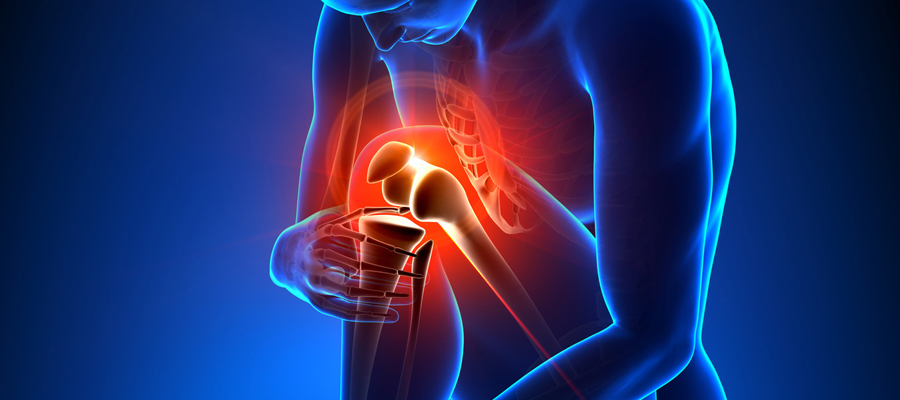
|
|
|
Bones And Joint treatment (ambawadi,ahmedabad)
|
Find Bones And Joint Treatment in ambawadi paldi Ahmedabad ? don't worry hemraj homeo clinic provide best bones joints treatment in ambawadi paldi ,ahmedabad. with high exceperinced doctor in ahmedabad. with best treatment in ahmedabad in bones and joints problem treatment.
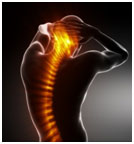
|
Our back is the most important yet highly abused part of our body. It bears the
load of our body throughout the life time. Any kind of strain, whether physical
or psychological, on the spine should not be overlooked. Hence, it is rightly mentioned
that when any unpleasant situation arises during the life cycle of a person it is
referred to as that it has ‘broken his back’. Most of the times it is the back which
bears the trauma of any fall or physical injury, which alters the whole lifestyle
of that person. The trauma maybe due to limitations of doing certain tasks or to
the extent of complete paralysis or a bed ridden condition. So why take even a small
pain in back lightly and suffer later of the consequences.
|
|
Instead get up and take care of it right away before it gets too late. Our back
bone or the vertebral column protects our spinal cord which is the nerve centre
for all the major activities in our body and is the link between our body and brain.
A very common disorder of spine, spondylisis, commonly occurs in the cervical and
lumbar vertebrae i.e. the neck and lower back. It can be defined as inflammatory
and degenerative condition of spine which is very painful and can upset a person’s
regular routine life.
|
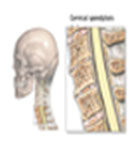
|
Spondylosis literally means stiffening or fixation of the bony building blocks of
the spine as a result of disease process like osteoarthritis. Spine degeneration
is a natural part of the aging process that is most common in the flexible and strong
lower back and neck. Over the years, natural wear and tear breaks down the spinal
anatomy, which results in a loss of flexibility and mobility, stiffness, and minor
aches and pains.
|
|
|
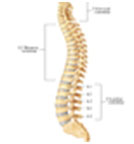
|
However, when cervical or lumbar spondylosis is accompanied by nerve compression,
a wider variety of painful symptoms can follow. The lumbar spine and cervical spine
are most prone to deterioration. Both segments of the spine are extremely flexible
and are required to support a significant weight of the body. This combination of
stress and mobility is the reason that neck and lower back pain are so common –
particularly as people grow older.
|
|
Causes of Spondylosis
|
|
• As mentioned before spondylosis is majorly as a result of degeneration due to
aging but it can also occur due to sudden trauma or accident.
|
|
• It is more commonly seen in males and mostly both cervical and lumbar spondylosis
occur simultaneously and when the process is degenerative and age related due to
prolonged stress the onset of symptoms is usually gradual, but if not taken care
it may lead to severe problems later.
|
|
• With age and wearing down of the bones of spine there is formation of bone spurs
which give rise to pain.
|
|
• The intervertebral disc degenerate and weaken, leading to disc herniation and
bulging of discs.
|
|
Symptoms of Spondylosis
|
|
Certain symptoms which are common to both cervical and lumbar spondylosis are:
|
|
• Pain in the affected part i.e. back or neck along with stiffness is the first
sign of spondylosis.
|
|
• Pain is either due to nerve compression or bone spurs on the facet joints causing
narrowing of the holes from where the nerve roots exit from the canal.
|
|
• Bulging discs can cause local inflammation and sensitization of the nerves of
the spine.
|
|
• The attempt of spine itself to splint because of reaction to pain causes local
tenderness, muscle spasms and trigger points.
|
|
In case of Lumbar Spondylosis
|
|
• If there is a large disc herniation it compresses the sciatic nerve root giving
rise to pain which originates in the lower back and travels down one leg into the
foot. This is known as Sciatica.
|
|
• This pain is typically worse with prolonged standing, sitting and forward bending
and is often better by changing positions and walking.
|
|
• Breaking or severe back pain due to osteoarthritic changes is worse from walking
and standing and is relieved by lying down and sometimes forward bending.
|
|
• Symptoms of tingling and numbness along with poor reflexes are felt when a nerve
is severely pinched.
|
|
• In case of severe nerve compression symptoms of loss of control on bladder and
bowel movements are observed and this calls for an emergency.
|
|
In case of Cervical Spondylosis
|
|
• Neck pain and stiffness are the most frequently seen symptoms and the person is
unable to do routine table work in his day to day life. The pain radiates to the
shoulder blades or arm too.
|
|
• Pressure on the nerve root causes giddiness and vertigo spells.
|
|
• If a large herniated disc or a spur puts pressure on the spinal cord it injures
the spinal cord and symptoms of myelopathy are observed.
|
|
• The symptoms of myelopathy are numbness, tingling and weakness and in arms and
also loss of grip on things while doing routine work.
|
|
Homeopathy for Spondylosis
|
|
• Homeopathy offers a very safe and encouraging cure in spodylosis though the treatment
is often long term but is without any side effects which are normally occurring
because of strong pain killers and in severe cases even steroids.
|
|
• In cases where the changes are mild the cure is faster and in advanced cases the
recovery is slow but any further degeneration is arrested and the pain and other
symptoms of patients are taken care of by safe medicines which can be consumed for
longer periods without any problem.
|
|
• Medicines like Rhustox, Guiacum arre very effective in treating stiffness of neck
and pain.
|
|
• Specific remedies like Kali carb and Zincum met are indicated for back pain and
stiffness, while wonder medicines like Conium takes care of the vertigo, Kalmia
gives relief from the tingling and numbness in extremities.
|
|
• Considering the concept of individualization and treating patient as a whole,
Homeopathy gives relief from the initial stages of stiffness and muscle pain when
there is a predisposition in cases with history of Osteoarthritis in the family.
|
|
• Certain biochemic remedies prevent further disc degeneration, formation of spurs
and provide essential minerals for bone and nerve health.
|
|
• Regular homeopathic mediciation improves the general health of the patient and
they are relieved of acute symptoms and are able to perform their regular routine
work and duties.
|
|
Homeopathic medicines have proven to help most individuals by reducing muscular
spasm/stiffness and relieve intensity /frequency of pain, without any long-term
adverse effects.
|
|
The medicines prescribed may be taken alone or along with your regular medicines
prescribed by your physician. Over time the need for pain killers and anti-inflammatory
drugs can subside and the overall condition of the bone and disc can be improved.
|
|
Symptoms are caused by a combination of pressure on the nerve root and muscle spasm,
and treatment is centered on relieving both of these factors.
|
|
Typically, the treatment offered at HRD involves the following:
|
|
• Prescribing purely Homeopathic medicines (No Steroids or NSAIDS) which have a
specific action on relieving nerve inflammation Prescribing essential Biochemic
remedies (Minerals) which prevent further disc degeneration and bone damage. Biochemic
medicines are made from Calcium, Magnesium etc.
|
|
HRD patients typically experience the following benefits:
|
|
• Relief in pressure and inflammation of the affected nerve.
|
|
• Disappearance in pain and tingling sensation radiating down the arm.
|
|
• Relief in headaches and stiffness of associated shoulder muscles.
|
|
• Improvement in the ability to function as normally as possible.
|
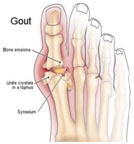
|
Many times referred as “Rheumatism of the Rich” gout is associated with over indulgence
of riches and wine which only a wealthy man can afford, but now the prevalence of
gout seems to be increasing and not limited to the kings and wealthy men. It is
a painful and potentially disabling form of arthritis that has been recognized since
ancient times.
|
|
Gout is a disease characterized by an abnormal metabolism of uric acid, resulting
in an excess of uric acid in the tissues and blood. People with gout either produce
too much uric acid, or more commonly, their bodies have a problem in removing it.
|
|
The possible consequences of this buildup of uric acid in the body include:
|
|
• Acute and chronic gouty arthritis
|
|
• Kidney stones
|
|
• Local deposits of uric acid (tophi) in the skin and other tissues.
|
|
|
|
Gout may occur alone (primary gout) or may be associated with other medical conditions
or medications (secondary gout).
|
|
|
|
It is the most common cause of inflammatory arthritis in men over the age of 40.
|
|
Causes of Gout
|
|
• Uric acid is generated as we metabolize the food we eat and as the body’s tissues
are broken down during normal cell turnover
|
|
• Gout occurs when excess uric acid (a normal waste product) accumulates in the
body, and needle‐like crystals deposit in the joints.
|
|
• It also occurs often when the kidneys are unable to remove uric acid from the
body adequately.
|
|
|
|
• Hereditary pre-disposition is also strongly indicated for a person to develop
gout.
|
|
|
|
• Intake of alcoholic beverages, especially beer, diets rich in red meats, internal
organs, yeast, and oily fish increases the risk for gout.
|
|
• Prolonged use of certain medicines like chemotherapy drugs and immunosuppressant’s,
diuretics and anti-hypertensive compounds also trigger gout.
|
|
• Gout is strongly associated with obesity, hypertension, hyperlipidemia and diabetes.
|
|
• The first symptom of gouty arthritis is typically the sudden onset of a hot, red,
swollen joint with pains mostly appearing at night.
|
|
• The most common joint involved is at the base of the big toe where swelling is
associated with severe tenderness. Apart from this any joint can be involved (for
example, knee, ankle, and small joints of the hands).
|
|
• The acute pain is so intense that even the touch of the bed sheet is intolerable.
|
|
• While the first attacks usually involve only one or two joints, multiple joints
are involved simultaneously over time.
|
|
• With time, attacks of gouty arthritis occur more frequently and last longer.
|
|
• Uric acid crystals also form outside small joints. Collections of these crystals,
known as tophi are found in the earlobe, elbow and Achilles tendon (back of the
ankle), or in other smaller joints ultimately causing pain around the area.
|
|
Homeopathic treatment of Gout
|
|
• Homeopathic medicines have a long history for treating and curing gout.
|
|
• Apart from giving relief in swelling and pain the medicines aid in the digestion
of the proteins, which cause the uric acid build-up thus nipping the bud before
the complaint becomes chronic and recurring in nature.
|
|
• Acute remedies like Aconite and Colchicum immediately help the patient in relieving
the traumatizing pain when administered in right potency and doses.
|
|
|
|
• Homoeopathic medicines can be a big boon for all those who suffer from high uric
acid. These medicines work by reducing the uric acid’s overproduction by the body
and accelerating the removal of this waste product from through the kidneys.
|
|
|
|
• Benzoic acid and Lycopodium are few of the indicated medicines which are helpful
in lowering the increased levels of uric acid.
|
|
• Berberis Vulgaris is the sure shot indicated medicine when gout is associated
with kidney stones.
|
|
• Once under the wings of Homeopathy the patient is free from relapses in case of
Gout and High Uric acid diathesis especially if he or she takes care and precaution
and brings a change in the diet and lifestyle.
|
|
Gout Prevention
|
|
If you are at risk for gout the following measures will help in controlling the
advancement of the condition along with proper medication:-
|
|
• Eat a low-cholesterol, low-fat diet.
|
|
• Avoid foods that are high in purines (the biochemical in foods that is metabolized
into uric acid), including shellfish and red meats.
|
|
|
|
• Slowly lose weight as this lowers the uric acid levels. Losing weight too rapidly
occasionally precipitates gout attacks.
|
|
|
|
• Restrict your intake of alcohol, especially beer.
|
|
• Stay hydrated.
|
|
• Increase your intake of dairy products, such as nonfat milk and yogurt, as they
lower the frequency of gout attacks.
|
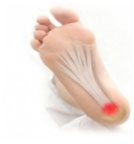
|
Every mile you walk puts 60 tons of stress on each foot. Your feet can handle a
heavy load, but too much stress pushes them over their limits. When you pound your
feet on hard surfaces by sporting activity or by wearing shoes that irritate sensitive
tissues, you may develop heel pain, the most common problem affecting the foot and
ankle in middle age. Many people try to ignore the early signs of heel pain and
keep on doing the activities that caused it and when you continue to use a sore
heel, it will only get worse and could become a chronic condition leading to more
problems.
|
|
Heel pain is an extremely common complaint, and there are several common causes.
If you have heel pain any of the following causes could be a reason:
|
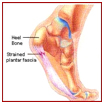
|
Plantar Fasciitis – Plantar fasciitis is the most common condition
that causes heel pain. Plantar Fasciitis is due to irritation and inflammation of
the tight tissue that forms the arch of the foot. Common symptoms of plantar fasciitis
include heel pain with prolonged walking and standing.
|
|
Tarsal Tunnel Syndrome -Tarsal tunnel syndrome causes a large nerve
in the back of the foot to become entrapped, or pinched. Similar to carpal tunnel
syndrome in the hand, tarsal tunnel syndrome can cause heel pain.
|
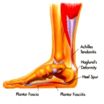
|
Heel Spur – A spur is commonly associated with plantar fasciitis.
This problem is most commonly seen in patients who have long standing heel pain
due to plantar fasciitis. A small bony growth occurs on the calcaneum which is the
supporting bone of the foot and ankle which irritates the supporting tendons and
causes pain.
|
|
Stress Fractures – Stress fractures of the calcaneus bone are an
uncommon cause of heel pain. Stress fractures should be considered especially in
athletes such as long distance runners who have heel pain.
|
|
Posterior Heel Pain -Posterior heel pain causes symptoms behind
the foot, rather than underneath. Posterior heel pain causes include Achilles tendonitis
and retrocalcaneal bursitis.
|
|
Homeopathic Help for Heel Pain
|
|
• It’s a wrong notion that homeopathy treatment gives relief only in long standing,
chronic complaints and does not give required relief in acute, painful conditions.
This is proved wrong by many patients who enter the clinic limping and agonized
in pain and when they come for a follow up visit in a weeks’ time they are perfectly
fine and have a smile on their face. Does anyone need more proof?
|
|
• We have some miraculous medicines which have helped more than 500 patients in
the last few years for heel pain, irrespective of the underlying cause.
|
|
• Amazingly effective medicines like Ledum Pal and Hypericum give the patient immediate
relief from the unbearable pain which he or she has been suffering since a long
time.
|
|
• Strong painkiller medicines are avoided and so the patient is also relieved of
the side effects of these medications like acidity, heartburn etc.
|
|
• Cinnabaris and Ranunculus are two more wonder drugs for spurs and the pinched
pain that gives patients days of agony and despair and he almost is bed ridden and
cannot even do his daily routine work efficiently.
|
|
• Let the hands of an able and experienced Homeopathic doctor hold you and let you
out of this agony. As its only experience and years of study that enable him to
decide on the medicine best suited for an individual.
|
|
Some Basic Tips to Help You Along
|
|
• Stop all impact sports and rest the foot especially if you are involved in some
heavy sporting activity, and remember this is only for few initial days.
|
|
• Stretching the plantar fascia and Achilles tendon with some simple exercises is
effective in reducing symptoms. The Doctor will help you with these stretching exercises.
|
|
• Use shoes with better heel cushioning, or include a heel cup or heel cushion for
preventing hard surface irritating the heels repeatedly while walking.
|
|
• Apply ice to the heel. Freeze a plastic bottle of water and roll your foot over
it. This is especially of benefit in acute pains.
|
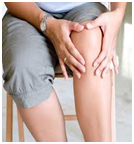
|
The inner most fear of every human being is reaching the stage in which he or she
becomes a burden on their family members. Let us help you overcome this fear and
heal your body and mind.
|
Osteoarthritis is the most common cause of joint disabilities in middle and old
age. It is a form of arthritis that features the breakdown and eventual loss of
the cartilage of one or more joints.. Osteoarthritis occurs more frequently as we
age. Before age 45, osteoarthritis occurs more frequently in males. After 55 years
of age, it occurs more frequently in females.
Osteoarthritis commonly affects the hands, feet, spine, and large weight-bearing
joints, such as the hips and knees. Osteoarthritis usually has no known cause and
is referred to as primary osteoarthritis. When the cause of the osteoarthritis is
known, the condition is referred to as secondary osteoarthritis.
|
|
Causes of Osteoarthritis
|
|
|
|
• Primary osteoarthritis not resulting from injury or disease, is mostly a result
of natural aging of the joint. With aging, the water content of the cartilage increases,
and the protein component of cartilage degenerates.
|
|
|
|
• In advanced osteoarthritis, there is a total loss of the cartilage cushion between
the bones of the joints. Repetitive use of the worn joints over the years can irritate
and inflame the cartilage, causing joint pain and swelling.
|
|
|
|
• Inflammation of the cartilage also stimulates new bony outgrowths (spurs, also
referred to as osteophytes) to form around the joints.
|
|
|
|
• Secondary osteoarthritis is a form of osteoarthritis that is caused by another
disease or condition. Conditions which lead to secondary osteoarthritis include
obesity, repeated trauma or surgery to the joint structures, abnormal joints at
birth (congenital abnormalities), gout, diabetes and other hormone disorders. Obesity
causes osteoarthritis by increasing the mechanical stress on the joint and therefore
on the cartilage.
|
|
|
|
• Repeated trauma to joint tissues (ligaments, bones, and cartilage) is believed
to lead to early osteoarthritis of the knees in soccer players and army military
personnel.
|
|
|
|
• Uric acid crystal deposits in the cartilage cause cartilage degeneration and osteoarthritis.
|
|
|
|
• Some people are born with abnormally formed joints (congenital abnormalities)
that are vulnerable to mechanical wear, causing early degeneration and loss of joint
cartilage. Osteoarthritis of the hip joints is commonly related to structural abnormalities
of these joints that had been present since birth.
|
|
|
|
• Hormone disturbances, such as diabetes and growth hormone disorders, are also
associated with early cartilage wear and secondary osteoarthritis.
|
|
Signs and symptoms of Osteoarthritis
|
|
|
|
• Grade I cases present with symptoms of pain in the affected joint(s) after repetitive
use. Joint pain of osteoarthritis is usually worse later in the day. There is swelling,
warmth, and creaking of the affected joints. Pain and stiffness of the joints occurs
after long periods of inactivity (for example, sitting in a theater).
|
|
|
|
• Grade II cases of severe osteoarthritis where there is complete loss of the cartilage
cushion causes friction between bones, causing pain even at rest or pain with limited
motion.
|
|
|
|
• Symptoms of osteoarthritis vary greatly from patient to patient. Some patients
are debilitated by their symptoms. On the other hand, others may have remarkably
few symptoms in spite of dramatic degeneration of the joints apparent on X-rays.
Symptoms also appear intermittently. It is not unusual for patients with osteoarthritis
of the finger joints of the hands and knees to have years of pain-free intervals
between symptoms.
|
|
|
|
• Grade III stage of Osteoarthritis of the knees is most of the time associated
with excess upper body weight, with obesity, or a history of repeated injury and/or
joint surgery. Progressive cartilage degeneration of the knee joints lead to deformity
and outward curvature of the knees, which is referred to as being “bowlegged”. People
with osteoarthritis of the weight-bearing joints (such as the knees) in the long
run develop a limp.
|
|
|
|
• Osteoarthritis of the cervical spine or lumbar spine causes pain in the neck or
low back. Bony spurs, called osteophytes, that form along the arthritic spine irritate
spinal nerves, causing severe pain which radiates from the spine along with numbness
and tingling of the affected parts of the body.
|
|
Homeopathic Treatment
|
|
|
|
• Homeopathic medicines are definitely suggested for Osteoarthritis, these medicines
slow down the degenerative process and offer considerable pain relief in Grade I
stage. 60 to 70 % of the cases are managed by homeopathy along with some basic exercises
and physiotherapy and the patient is saved from the effects of anti-inflammatory
drugs. There is marked improvement in the stability and weight bearing capacity
especially of knee joints with Acid Benzoic, Sticta and many other such indicated
homeopathic remedies.
|
|
|
|
• About 60-70% of severe cases with Synovitis and fluid collection show response
to homeopathic medicine like Iodium and Apis within hours thus avoiding tapping
and analysis of fluid unless tubercular or malignant changes are suspected. Homeopathy
medicines Argentum Nitricum and Slag carry out the role of Glucosamine and take
care of cartilages and are well tolerated by the patients.
|
|
|
|
• In cases where arthroscopy is said to be inevitable, homeopathic medicines save
the patient from the procedure and even elderly people then independently do their
routine work and also jobs if they want to. Suggested intercurrent medicines called
Nosodes are prepared from the diseased tissue (Osteo Arthritic Nosode) are known
to tackle adverse cases.
|
|
|
|
• Homeopathic medicines also help to improve the general health, control obesity
and deeper study of the cases help in tackling the root cause and take care of the
familial tendencies thus reducing the progress of the condition.
|
|
|
|
• Precise homeopathic medicines like Conium and Spigelia are highly beneficial for
knee cap ailments and reduce Osteophytes by 30-40%.
|
|
|
|
• People opting for knee replacement should not forget that the life of the replaced
joint is also 12-13 years and largely dependent on the usage of the joint so if
done in young and middle age group the complaints may return after a few years of
wear and tear.
|
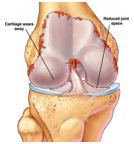
|
In the journey of life every step takes us closer to our future & goals. Every step
has to be free of any stress so that the journey of Life becomes enjoyable. But
nowadays we see many people struggling for a comfortable walk because of the commonly
known condition called Arthritis. Contrary to what everyone believes this condition
is not related to age hence when it occurs in young people it takes its toll on
their complete life journey. Let us tell you something more about Rheumatoid Arthritis
commonly referred to as Arthritis.
|
|
Rheumatoid arthritis (RA) is an autoimmune disease that causes chronic inflammation
of the joints. While inflammation of the tissue around the joints and inflammatory
arthritis are characteristic features of rheumatoid arthritis, the disease also
causes inflammation and injury in other organs in the body.
|
|
Patients with autoimmune diseases have antibodies in their blood that target their
own body tissues, where they are associated with inflammation. As it affects multiple
other organs of the body, rheumatoid arthritis is referred to as a systemic illness
and is sometimes called rheumatoid disease.
|
|
While Rheumatoid Arthritis is a chronic illness, meaning it lasts for years, patients
may experience long periods without symptoms. However, rheumatoid arthritis is typically
a progressive illness that has the potential to cause joint destruction and functional
disability.
|
|
The joint inflammation of Rheumatoid Arthritis causes swelling, pain, stiffness,
and redness in the joints. The inflammation of rheumatoid disease can also occur
in tissues around the joints, such as the tendons, ligaments, and muscles.
|
|
In some people with Rheumatoid Arthritis, chronic inflammation leads to the destruction
of the cartilage, bone, and ligaments, causing deformity of the joints. Damage to
the joints occur early in the disease and are progressive. Moreover, studies have
shown that the progressive damage to the joints does not necessarily correlate with
the degree of pain, stiffness, or swelling present in the joints.
|
|
Rheumatoid Arthritis is a common Rheumatic disease & is three times more common
in women as in men. It afflicts people of all races equally. The disease begin at
any age and even affects children (juvenile rheumatoid arthritis), but it most often
starts after 40 years of age and before 60 years of age. In some families, multiple
members are affected, suggesting a genetic basis for the disorder.
|
|
Causes of Rheumatoid Arthritis
|
|
• The cause of rheumatoid arthritis is unknown. Even though infectious agents such
as viruses, bacteria, and fungi have long been suspected, none has been proven as
the cause.
|
|
• It is believed that the tendency to develop rheumatoid arthritis may be genetically
inherited (hereditary). Certain genes have been identified that increase the risk
for rheumatoid arthritis.
|
|
• It is also suspected that certain infections or factors in the environment might
trigger the activation of the immune system in susceptible individuals. This misdirected
immune system then attacks the body’s own tissues. This leads to inflammation in
the joints and sometimes in various organs of the body, such as the lungs or eyes.
|
|
Signs & Symptoms of Rheumatoid Arthritis
|
|
The symptoms of rheumatoid arthritis come and go, depending on the degree of tissue
inflammation. When body tissues are inflamed, the disease is active. When tissue
inflammation subsides, the disease is inactive (in remission).
|
|
When the disease is active the symptoms can include:
|
|
• Fatigue
|
|
• Muscle & joint stiffness & aches especially in the mornings & after periods of
inactivity.
|
|
• In severe cases the joints become red, swollen & tender.
|
|
• Loss of energy & lack of appetite
|
|
• Rheumatoid arthritis usually affects multiple joints in a symmetrical pattern.
|
|
• The small joints of both the hands and wrists are often involved. Symptoms in
the hands with rheumatoid arthritis include difficulty with simple tasks of daily
living, such as turning door knobs and opening jars. The small joints of the feet
are also commonly involved, which lead to painful walking.
|
|
• Chronic inflammation cause damage to body tissues, including cartilage and bone.
This leads to a loss of cartilage and erosion and weakness of the bones as well
as the muscles, resulting in joint deformity, destruction, and loss of function.
|
|
• Rarely, rheumatoid arthritis affect the joint that is responsible for the tightening
of our vocal cords to change the tone of our voice, the cricoarytenoid joint. When
this joint is inflamed, it causes hoarseness of the voice. Symptoms in children
with rheumatoid arthritis include limping, irritability, crying, and poor appetite.
|
|
Complications of Rheumatoid Arthritis
|
|
Since rheumatoid arthritis is a systemic disease, its inflammation can affect
organs and areas of the body other than the joints:
|
|
|
|
• Inflammation of the eyes causes dryness & corneal abrasions & inflammation of
sclera causes sceleritis which is a very serious condition.
|
|
• Rheumatoid inflammation of the lung lining (pleuritis) causes chest pain with
deep breathing, shortness of breath, or coughing.
|
|
• Inflammation of the tissue (pericardium) surrounding the heart, called pericarditis,
causes a chest pain that typically changes in intensity when lying down or leaning
forward.
|
|
• Rheumatoid disease reduces the number of red blood cells (anemia) and white blood
cells.
|
|
• Nerves often become pinched in the wrists to cause carpal tunnel syndrome.
|
|
• Firm lumps under the skin (rheumatoid nodules) occur around the elbows and fingers
where there is frequent pressure. Even though these nodules usually do not cause
symptoms, they sometimes become infected.
|
|
Homeopathy for Rheumatoid Arthritis
|
|
Homeopathy offers excellent treatment for the cases of RA, especially for those
who have not developed joint deformities. The pain control is very effective with
homeopathy and this is without any side effects whatsoever. The treatment also has
a role to play in controlling the progress of the condition to some extent and in
delaying the onset of complications.
|
|
|
|
As we know that homeopathy takes into consideration the person as a whole the treatment
& a holistic approach is what benefits the patient in the long run.
|
|
Conventional medicine helps only to ease pain through painkillers & boosting the
immune system with steroids but the side effect of these medicines adds to the worries
of the patient rather than giving relief.
|
|
Certain homeopathic medicines like Byonia, Rhustox, Colchicum help the patient to
get relief from the symptoms.
|
|
Deep acting polycrest medicines help in curtailing the miasmatic factor & thus preventing
further progress of the disease.
|
|
Complications of RA can be arrested with homeopathic treatment & the patient can
have a better quality of life.
|
|
On reading the above quote we realize what an important part an elbow plays in our
life. It is the elbow which makes our daily morsel reach our mouth and imagine if
one has restricted movement of this precious joint what he would go through.
|
|
Commonly known as “Tennis Elbow” this is a condition wherein there is inflammation
of the tendons on the outer bony prominence (Lateral Epicondyle) of the elbow that
join the forearm muscles to the outside of the elbow. Certain repetitive movements
of the wrist like playing tennis or other racquet sports leads to overuse of these
tendons causing pain and tenderness on the outer side of elbow.
|
|
Tennis elbow can occur in anyone who strains the tendons of the forearm and though
common it is not limited to tennis players.
|
|
Tennis Elbow Causes
|
|
• Any repetitive motion of the wrist, including tennis, hedge clipping, excessive
use of a hammer or screwdriver, painting, or any activity that requires excessive
constant gripping or squeezing can cause tennis elbow. Recent studies show that
tennis elbow is often due to damage to a specific forearm muscle i.e. the extensor
carpi radialis brevis (ECRB) muscle which helps stabilize the wrist when the elbow
is straight.
|
|
• Most people who get tennis elbow are between the ages of 30 and 50, although anyone
can get tennis elbow if they have the risk factors of being involved in certain
professions like painters, carpenters, auto workers, cooks and butchers.
|
|
Tennis Elbow Symptoms and Signs
|
|
• Tenderness on the outer bony part of the elbow
|
|
• Morning stiffness of the elbow with persistent aching
|
|
• Pain radiating down the forearm causing soreness in the forearm.
|
|
• Pain worse when grasping or holding an object
|
|
Homeopathic Help for Tennis Elbow
|
|
Effective and fast acting medicines like Arnica, Ruta lessen down the misery and
pain of the patients with immediate effect.
|
|
The medicines not only give relief from pain but also help to heal the tendons and
the strained muscles completely making them stronger and not easily prone to wear
and tear.
|
|
A dull pain worse in cold weather is benefitted by Ruta while tearing and excruciating
pains worse by motion are eased by Bryonia.
|
|
The dosage and frequency of the medicines decided by an expert homeopath will always
take the patient out of misery and back to his routine work without him going through
any surgical(local steroidal injections) and heavy doses of painkiller drugs and
their adverse effects.
|
|
Certain General Precautionary Measures to Help Heal Better
|
|
• Rest and avoid any activity that causes pain to the sore elbow till totally free
from pain and then resume work gradually.
|
|
• Apply ice to the affected area.
|
|
• To help lessen the continued stress and abuse on tennis elbow:
|
|
1. Use the proper equipment and technique in sports and on the job.
|
|
2. Use of a counter-force brace, an elastic band that wraps around the forearm just
below the injured elbow (tendon) may help to relieve pain in some people.
|
|
|
|
|
|
|
|
© 2018 | HEMRAJ HOMEO CLINIC | All Rights Reserved. Design By Business7days.
|
|
|
|
